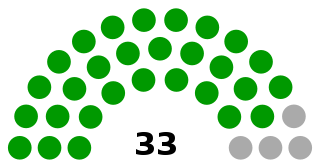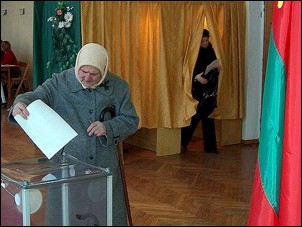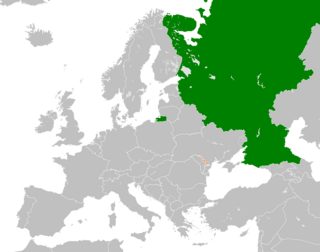
Tiraspol ; occasionally also known in Romanian as Tirișpolea) is the de facto capital of Transnistria, a breakaway state of Moldova, where it is the third largest city. The city is located on the eastern bank of the Dniester River. Tiraspol is a regional hub of light industry, such as furniture and electrical goods production.

Transnistria, officially the Pridnestrovian Moldavian Republic (PMR), is an unrecognised breakaway state that is internationally recognised as a part of Moldova. Transnistria controls most of the narrow strip of land between the Dniester river and the Moldovan–Ukrainian border, as well as some land on the other side of the river's bank. Its capital and largest city is Tiraspol. Transnistria has been recognised only by three other unrecognised or partially recognised breakaway states: Abkhazia, Artsakh and South Ossetia. Transnistria is officially designated by the Republic of Moldova as the Administrative-Territorial Units of the Left Bank of the Dniester or as Stînga Nistrului. In March 2022, the Parliamentary Assembly of the Council of Europe adopted a resolution that defines the territory as under military occupation by Russia.

Igor Nikolaevich Smirnov is a Russian-born Transnistrian politician who served as the first president (1991–2011) of the internationally unrecognized Pridnestrovian Moldovan Republic.
Transnistria is a region in Eastern Europe that is under the effective control of the self-declared Pridnestrovian Moldavian Republic but is recognized by the international community as an administrative unit of Moldova, the Administrative-Territorial Units of the Left Bank of the Dniester.
Transnistria is a region in Eastern Europe that is under the effective control of the self-declared Pridnestrovian Moldavian Republic but is recognized by the international community as an administrative unit of Moldova, the Administrative-Territorial Units of the Left Bank of the Dniester.

The Supreme Council of the Pridnestrovian Moldavian Republic is the parliament of Transnistria. The unicameral legislature consists of 33 seats, all of which are determined by single mandate constituencies. It is headed by a chairman.

The Transnistria conflict is an ongoing frozen conflict between Moldova and the unrecognized state of Transnistria. Its most active phase was the Transnistria War. There have been several attempts to resolve the conflict, although none have been successful. The conflict may be considered as having started on 2 September 1990, when Transnistria made a formal sovereignty declaration from Moldova.

This is the history of Transnistria, officially the Pridnestrovian Moldavian Republic (PMR), is an unrecognised breakaway state that is internationally recognised as part of Moldova. Transnistria controls most of the narrow strip of land between the Dniester river and the Moldovan–Ukrainian border, as well as some land on the other side of the river's bank. See also the history of Europe.

The current Constitution of Transnistria was approved by national referendum on 24 December 1995, and signed into law by the President of Transnistria on 17 January 1996. As part of the territory's move towards market based reforms, it was modified on 30 June 2000.

A double referendum was held in Transnistria on 17 September 2006. Voters were asked whether they approved of the possibility of renouncing independence and integration with Moldova, or alternatively independence and a possible future integration into the Russian Federation.

The Pridnestrovian Moldavian Soviet Socialist Republic (PMSSR), also commonly known as Soviet Transnistria or simply as Transnistria, was created on the eastern periphery of the Moldavian Soviet Socialist Republic (MSSR) in 1990 by pro-Soviet separatists who hoped to remain within the Soviet Union when it became clear that the MSSR would achieve independence from the USSR and possibly unite with Romania. The PMSSR was never recognised as a Soviet republic by the authorities in either Moscow or Chișinău. In 1991, the Pridnestrovian Moldavian Republic succeeded the Pridnestrovian Moldavian Soviet Socialist Republic.

Referendums in Transnistria, according to the Transnistrian Constitution, are one of the lawful forms of expression of people's will.

The Government of Pridnestrovian Moldavian Republic is the political leadership of the unrecognized, but de facto independent, Pridnestrovian Moldavian Republic, better known in English as Transnistria.

International recognition of Transnistria – a disputed region in Eastern Europe located between Moldova and Ukraine – is controversial. Although Transnistria declared independence in 1990, no United Nations member recognises its sovereignty and the region is considered by the UN to be part of Moldova. Currently, only Abkhazia, the Republic of Artsakh and South Ossetia recognise its independence, all themselves states with limited recognition. Despite not officially recognizing Transnistria's independence, Russia has close relations with Transnistria and even established a consulate in the territory. The Council of Europe considers the region an Russian-occupied territory.

A referendum on the formation of the Pridnestrovian Moldavian Soviet Socialist Republic was held in Transnistria between 1989 and 1990. The first voting took place in Rîbnița on 3 December 1989. In Tiraspol voting was held on 28 January. After the June congress of the local Soviet, voting was held in the districts of Bender, Dubăsari, Sloboza, Camenca and Grigoriopol. The overall total showed 95.8% voting in favour. The Pridnestrovian Moldavian Soviet Socialist Republic was declared at the second meeting of the Soviet on 2 September 1990.

The Administrative-Territorial Units of the Left Bank of the Dniester (Transnistria) is a formal administrative unit of Moldova established by the Government of Moldova to delineate the territory controlled by the unrecognized Pridnestrovian Moldavian Republic.

Women in Transnistria are women who live in or are from Transnistria.

Moldova–Transnistria relations are the political and economic relations between the Republic of Moldova and Transnistria, an unrecognized state between the Dniester River and Ukraine. During the dissolution of the Soviet Union, political tensions in the Moldavian Soviet Socialist Republic led to Transnistria declaring independence from Moldova, culminating in the Transnistrian War of 1992. As part of the ceasefire agreement ending the war, a Joint Control Commission composed of Moldovan, Transnistrian, and Russian forces was established to supervise the demilitarized zone which was located in the Transnistrian region. The Joint Control Commission still supervises the zone, and negotiations to resolve the dispute are ongoing. The negotiations are supported by the Russian Federation, Ukraine, the United States, the European Union, and the Organization for Security and Co-operation in Europe (OSCE).

Russia–Transnistria relations are the bilateral relations between the Pridnestrovian Moldavian Republic (Transnistria), an unrecognised breakaway state that is internationally recognised as part of Moldova, and the Russian Federation. Russia does not officially recognise the independence of Transnistria; nevertheless, Russia maintains special relations with Transnistria in the political, military, cultural, and economic spheres.

Artsakh–Transnistria relations are the foreign relations between the unrecognised republics of Artsakh and Transnistria. Both countries officially established diplomatic relations on 4 July 2001 and currently recognize each other's independence. Both states are members of the Community for Democracy and Rights of Nations.















